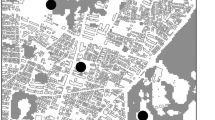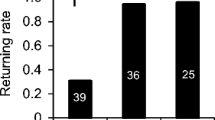Abstract
Homing toward specific places is critical for the survival and reproduction of motile animals and can influence the spatial range of animal behavior. The homing distance often varies temporally, which has been thoroughly studied in the context of foraging in social Hymenopteran insects, but little is known about the variation in males engaging in mating. This study released males of different ages with guaranteed flight experience in locations at various distances from the colony and evaluated how, over time, honeybee males change the distances they can travel when homing toward their colony. Furthermore, the effect of age and flight experience on flight ability was investigated to evaluate their effect on homing performance. This study found that older males can return to the colony from a greater distance and faster than younger males and also that flight ability did not vary due to males’ age and flight experience. The results suggest that males could undergo a behavioral process that enables them to expand their homing range. This temporal variation provides an insight into the expansion of males’ dispersal distance, which reduces the possibility of inbreeding and male–male competition.






Similar content being viewed by others
References
Baer B (2005) Sexual selection in Apis bees. Apidologie 36:187–200
Becker L (1958) Untersuchungen über das Heimfindevermögen der Bienen. Zeitschrift für Vergleichende Physiol 41:1–25
Campbell AJ, Gomes RLC, da Silva KC, Contrera FAL (2019) Temporal variation in homing ability of the neotropical stingless bee Scaptotrigona aff. postica (Hymenoptera: Apidae: Meliponini). Apidologie 50:720–732
Capaldi EA, Dyer FC (1999) The role of orientation flights on homing performance in honeybees. J Exp Biol 202:1655–1666
Capaldi EA, Smith AD, Osborne JL, Fahrbach SE, Farris SM, Reynolds DR, Edwards AS, Martin A, Robinson GE, Poppy GM, Riley JR (2000) Ontogeny of orientation flight in the honeybee revealed by harmonic radar. Nature 403:537–540
Collett TS, Collett M (2002) Memory use in insect visual navigation. Nat Rev Neurosci 3:542–552
Degen J, Kirbach A, Reiter L, Lehmann K, Norton P, Storms M, Koblofsky M, Winter S, Georgieva PB, Nguyen H, Chamkhi H, Greggers U, Menzel R (2015) Exploratory behaviour of honeybees during orientation flights. Anim Behav 102:45–57
Degen J, Kirbach A, Reiter L, Manz G, Greggers U, Menzel R (2016) Honeybees learn landscape features during report honeybees learn landscape features during exploratory orientation flights. Curr Biol 26:2800–2804
dos Santos CF, Imperatriz-Fonseca VL, Arias MC (2016) Relatedness and dispersal distance of eusocial bee males on mating swarms. Entomol Sci 19:245–254
Fahrbach SE, Giray T, Farris SM, Robinson GE (1997) Expansion of the neuropil of the mushroom bodies in male honey bees is coincident with initiation of flight. Neurosci Lett 236:135–138
Galindo-Cardona A, Monmany AC, Diaz G, Giray T (2015) A landscape analysis to understand orientation of honey bee (Hymenoptera: Apidae) drones in Puerto Rico. Environ Entomol 44:1139–1148
Gmeinbauer R, Crailsheim K (1993) Glucose utilization during flight of honeybee (Apis mellifera) workers, drones and queens. J Insect Physiol 39:959–967
Goulson D, Stout JC (2001) Homing ability of the bumblebee Bombus terrestris (Hymenoptera: Apidae). Apidologie 32:105–111
Greenleaf SS, Williams NM, Winfree R, Kremen C (2007) Bee foraging ranges and their relationship to body size. Oecologia 153:589–596
Hamilton WD (1967) Extraordinary sex ratios. Science (80-) 156:477–488
Hasegawa E, Yamaguchi T (1995) Population structure, local mate competition, and sex-allocation pattern in the ant Messor aciculatus. Evolution (N Y) 49:260–265
Hayashi S, Farkhary SI, Takata M, Satoh T, Koyama S (2017) Return of drones: flight experience improves returning performance in honeybee drones. J Insect Behav 30:237–246
Hedrick P, Gadau J, Page REJ (2006) Genetic sex determination and extinction. Trends Ecol Evol 21:55–57
Heimpel GE, de Boer JG (2008) Sex determination in the Hymenoptera. Annu Rev Entomol 53:209–230
Howell DE, Usinger RL (1933) Observations on the flight and length of life of drone bees. Ann Entomol Soc Am 26:239–246
Hrassnigg N, Crailsheim K (2005) Differences in drone and worker physiology in honeybees (Apis mellifera). Apidologie 36:255–277
Ichikawa N, Sasaki M (2003) Importance of social stimuli for the development of learning capability in honeybees. Appl Entomol Zool 38:203–209
Jaffé R, Dietemann V, Crewe RM, Moritz RFA (2009) Temporal variation in the genetic structure of a drone congregation area: An insight into the population dynamics of wild African honeybees (Apis mellifera scutellata). Mol Ecol 18:1511–1522
Jensen AB, Palmer KA, Chaline N, Raine NE, Tofilski A, Martin SJ, Pedersen BV, Boomsma JJ, Ratnieks FLW (2005) Quantifying honey bee mating range and isolation in semi-isolated valleys by DNA microsatellite paternity analysis. Conserv Genet 6:527–537
Koeniger N, Koeniger G, Pechhacker H (2005) The nearer the better? Drones (Apis mellifera) prefer nearer drone congregation areas. Insectes Soc 52:31–35
Koeniger G, Koeniger N, Phiancharoen M (2011) Comparative reproductive biology of honeybees. In: Honeybees of Asia. Springer, Berlin, pp 159–206
Koeniger G, Koeniger N, Ellis J, Conner L (2014) Mating biology of honey bees (Apis mellifera). Wicwas Press
Kraus FB, Wolf S, Moritz RFA (2009) Male flight distance and population substructure in the bumblebee Bombus terrestris. J Anim Ecol 78:247–252
Lensky Y, Cassier P, Notkin M, Delorme-Joulie C, Levinsohn M (1985) Pheromonal activity and fine structure of the mandibular glands of honeybee drones (Apis mellifera L.)(Insecta, Hymenoptera, Apidae). J Insect Physiol 31:265–276
Loper GM (1985) Influence of age on the fluctuation of iron in the oenocytes of honey Bee (Apis mellifera) Drones. Apidologie 16:181–184
Loper GM, Wolf WW, Taylor ORJ (1992) Honey bee drone flyways and congregation areas: radar observations. J Kansas Entomol Soc 65:223–230
Mattila HR, Reeve HK, Smith ML (2012) Promiscuous honey bee queens increase colony productivity by suppressing worker selfishness. Curr Biol 22:2027–2031
Mattila HR, Seeley TD (2007) Genetic diversity in honey bee colonies enhances productivity and fitness. Science (80-) 317:362–364
Menzel R, Brandt R, Gumbert A, Komischke B, Kunze J (2000) Two spatial memories for honeybee navigation. Proc R Soc B Biol Sci 267:961–968
Menzel R, Greggers U, Smith A, Berger S, Brandt R, Brunke S, Bundrock G, Hulse S, Plumpe T, Schaupp F, Schuttler E, Stach S, Stindt J, Stollhoff N, Watzl S (2005) Honey bees navigate according to a map-like spatial memory. Proc Natl Acad Sci 102:3040–3045
Moritz RFA (1988) Biochemical changes during honey bee flight muscle development. Biona Rep 6:51–64
Page REJ, Metcalf RA (1984) A population investment sex ratio for the honey bee (Apis mellifera L.). Am Nat 124:680–702
Papi F (1992) Animal homing. Chapman and Hall, London
Peer DF (1957) Further studies on the mating range of the honey bee, Apis mellifera L. Can Entomol 89:108–110
Poidatz J, Monceau K, Bonnard O, Thiéry D (2018) Activity rhythm and action range of workers of the invasive hornet predator of honeybees Vespa velutina, measured by radio frequency identification tags. Ecol Evol 8:7588–7598
Reyes M, Crauser D, Prado A, Le Conte Y (2019) Flight activity of honey bee (Apis mellifera) drones. Apidologie 50:669–680
Rinderer TE, Oldroyd BP, Wongsiri S, Sylvester HA, Guzman LID, Potichot S, Sheppard WS, Buchmann SL (1993) Time of drone flight in four honey bee species in south-eastern Thailand. J Apic Res 32:27–33
Rueppell O, Page REJ, Fondrk MK (2006) Male behavioural maturation rate responds to selection on pollen hoarding in honeybees. Anim Behav 71:227–234
Ruttner F (1966) The life and flight activity of drones. Bee World 47:93–100
Ruttner F, Ruttner H (1966) Investigations on the flying activity and the mating behaviour of drones. 3. range and direction of drone flights. Z Bienenforsch 8:332–354
Ruttner H, Ruttner F (1972) Investigations on the flying activity and the mating behaviour of drones 5. drone congregation areas and mating distance. Apidologie 3:203–232
Taylor ORJ, Rowell GA (1988) Drone abundance, queen flight distance, and the neutral mating model for the honey bee, Apis mellifera. In: Needham GR, Page REJ, Delfinado-Baker M, Bowman CE (eds) Africanized honey bees and bee mites. Ellis Horwood, pp 173–183
Utaipanon P, Holmes MJ, Chapman NC, Oldroyd BP (2019) Estimating the density of honey bee (Apis mellifera) colonies using trapped drones: area sampled and drone mating flight distance. Apidologie 50:578–592
Van Nieuwstadt MGL, Iraheta CER (1996) Relation between size and foraging range in stingless bees (Apidae, Meliponinae). Apidologie 27:219–228
Winston ML (1987) The biology of the honey bee. Harvard University Press, Cambridge
Witherelli PC (1971) Duration of flight and of interflight time of drone honey bees, Apis mellifera. Ann Entomol Soc Am 64:609–612
Yoshida T, Saito J, Kajigaya N (1994) The mating flight times of native Apis cerana japonica Radoszkowski and introduced Apis mellifera L. in sympatric conditions. Apidologie 25:353–360
Zmarlicki C, Morse RA (1963) Drone congregation areas J Apic Res 2:64–66
Acknowledgements
We would like to thank Prof. Madoka Nakai and Dr. Maki Inoue for providing helpful comments on this study.
Author information
Authors and Affiliations
Corresponding author
Supplementary Information
Below is the link to the electronic supplementary material.
Rights and permissions
About this article
Cite this article
Hayashi, S., Sasaki, T., Farkhary, S.I. et al. Age-related variation of homing range in honeybee males (Apis mellifera). Insect. Soc. 69, 37–45 (2022). https://doi.org/10.1007/s00040-021-00843-3
Received:
Revised:
Accepted:
Published:
Issue Date:
DOI: https://doi.org/10.1007/s00040-021-00843-3




